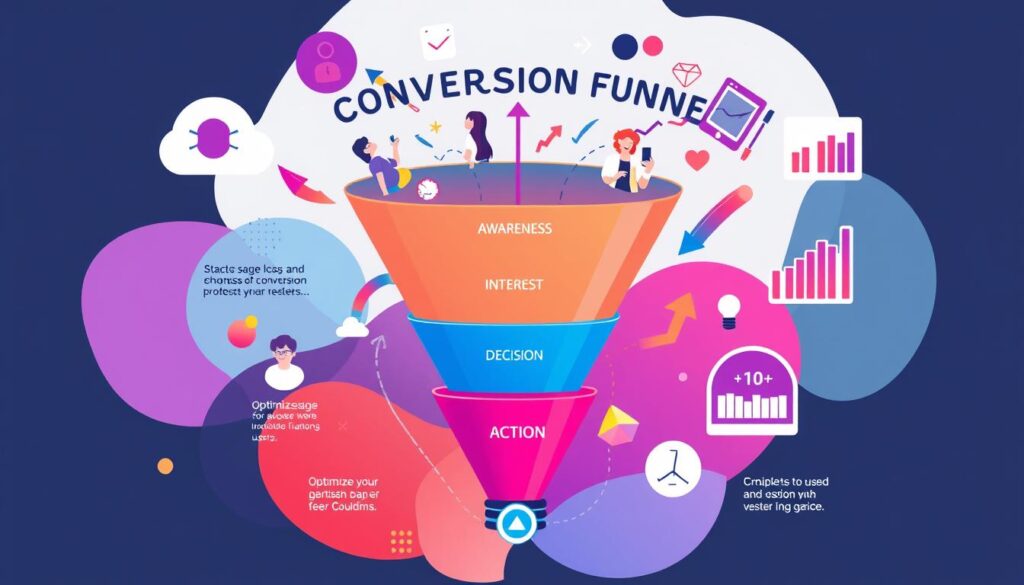In today’s online world, attracting visitors isn’t enough for success. Businesses need to turn them into loyal fans. Conversion Rate Optimization (CRO) is vital for this conversion. It uses strategies to boost engagement and profit. CRO involves techniques to get visitors to act, like buying or signing up.
Creating a good CRO strategy means understanding what users want. Since about 69.23% of shoppers leave their carts, it’s crucial to make the checkout smoother. Knowing that landing pages convert at 23% on average can guide CRO efforts.
Data analytics help marketers find ways to improve. For example, Bombas increased logins by 36% by changing their login CTA from an icon to text. Using data helps businesses create a more attractive online space. It meets customer needs better.
Key Takeaways
- Implementing CRO strategies can result in significant improvements in user engagement and conversion rates.
- Understanding and analyzing user behavior are essential to determine effective optimization techniques.
- Clearly defined website goals and regular tracking of conversions guide a successful CRO journey.
- Data from A/B tests and analytics tools inform decision-making processes for higher conversions.
- Continuous refinement and testing play a crucial role in adapting to consumer needs and boosting conversion rates.
- The right optimization of checkout processes and CTAs can mitigate cart abandonment and enhance sales.
Understanding Conversion Rate Optimization (CRO)
Businesses today are focusing on conversion rate optimization (CRO) to boost their online performance. CRO involves refining user experiences and tweaking marketing to increase website conversions. It’s about strategically overhauling a site, based on analytics and feedback, not just minor changes.
What is Conversion Rate Optimization?
Conversion Rate Optimization is about using different techniques to boost the percentage of users who take a desired action on a website. Actions like filling out a form, subscribing, or buying something are considered conversions.
By using A/B testing, analyzing user journeys, and employing behavioral analytics, CRO improves user experiences. With CRO best practices, like speeding up page loads and personalizing experiences, companies can drastically improve their conversion rates.
Importance of CRO for Businesses
In the digital world, engaging effectively online is key for businesses. Applying conversion rate optimization tips changes how companies interact with potential customers online. Let’s look at why CRO is so crucial:
- It makes marketing budgets more effective by boosting conversion rates, achieving more with less spend.
- CRO provides deeper insights into customer behavior, helping businesses meet their needs better.
- Improving conversion rates leads to a better return on investment (ROI) on digital platforms.
- It focuses on making user experiences better, smoothing the site journey, and increasing conversions.
Consider a landing page with a 10% conversion rate and 2000 monthly visitors, generating 200 conversions. By increasing the conversion rate to 15% through effective CRO, conversions jump to 300. This not only shows efficiency but also the direct impact of CRO on growth.
CRO is a cycle of learning, testing, and improving. Insights from over 127,000 experiments show the scope and effort needed for success. Companies must embrace CRO’s iterative nature, constantly responding to feedback and changes in the market. This ongoing effort can lead to not just more conversions, but broader success online.
Key Metrics for Measuring Conversion Rates
Effective conversion rate optimization makes digital platforms work better and engage users more. By focusing on key metrics, companies can make their conversion funnels better. These funnels help turn visits into valuable actions. Let’s look at the most important metrics for improving conversion rates.
Click-Through Rate (CTR)
Click-through rate measures how effective online ads and campaigns are. It’s about the clicks an ad gets compared to how many times it’s seen. A high CTR means a campaign is drawing interest and making people want to learn more.
Bounce Rate
Bounce rate shows the percentage of visitors who leave after seeing just one page. It helps understand if your landing pages are engaging users or not. A high bounce rate suggests your content isn’t keeping visitors interested.
Conversion Rate
The conversion rate shows the percentage of visitors who do what you want them to on your site. This might be buying something, signing up, or filling out a form. It tells you how good your site is at moving visitors towards your goals.

Here are more key metrics for improving your conversion rate optimization:
| Metric | Description | Impact |
|---|---|---|
| Average Order Value (AOV) | Average amount a customer spends during a transaction | Higher AOV means more money per sale |
| Customer Acquisition Cost (CAC) | How much it costs to get a new customer | Lower CAC indicates better use of marketing dollars |
| Funnel Conversion Rate | Shows how well a sales funnel turns users into customers | It helps find leaks in the sales process |
| Cart Abandonment Rate | Looks at who puts items in a cart but doesn’t buy | Lower rates show an improved checkout process |
| Customer Lifetime Value (CLV) | Estimates profit from a customer over time | A higher CLV points to better profits per customer |
Analyzing these metrics gives insights into user engagement and effective conversion strategies. Understanding and improving these key areas can boost user experience and conversion rates significantly.
Best Practices for Improving CRO
To increase online conversions, follow top strategies for conversion rate optimization (CRO). Make your website design simple, create strong calls to action, and improve the overall user experience. These steps are key to success.
Simplifying Your Website Design
Making your website design simple is crucial. It helps your site work better. By focusing on easy-to-understand layouts and clear visuals, users get less frustrated. This helps guide them easily through your site. For example, Quip changed their product pages and saw a 4.7% rise in sales. This shows that good design really makes a difference in conversions.
Crafting Compelling Calls to Action
Effective calls to action (CTAs) are vital. They play a big role in engaging users and are key in CRO strategies. Use action words and contrasting colors for your CTAs. This helps guide what users do. Carl Ras, for example, boosted their conversion rates by 20% just by tweaking their CTAs and testing different versions.
Enhancing User Experience
Improving user experience involves many things. It’s about making your website fast and writing persuasive text. It also means making things like paying simple. Over 92% of optimization tests aim to improve things like clicks on CTAs and the checkout experience. This is because better user experiences lead to more sales.
| Strategy | Impact on Conversion Rate |
|---|---|
| Personalized Experiments | 41% more impact |
| Utilizing Trust Signals | Significant increase in customer conversions |
| Mobile Optimization | Crucial, as major online traffic is from mobile devices |
| Systematic CRO Approach | Yields more significant gains than isolated changes |
A/B Testing: A Fundamental Approach
A/B Testing, or split testing, is key in making websites work better. It involves testing two versions of a website element to see which one does better. This method helps turn guesses into facts backed by data.
What is A/B Testing?
A/B testing makes website improvement simpler. It shows two versions of something, like a page or a call to action, to different people at the same time. The aim is to find out which version performs better, using facts to decide what to change. This way, decisions are based on real evidence, not guesses. A/B testing also helps make websites more user-friendly, encouraging more conversions.
Tools for Effective A/B Testing
For successful A/B testing, you need the right tools. Google Optimize, VWO, and Optimizely are among the best. They help set up tests and understand the results well. Features include:
- Easy setup of test variants
- Comprehensive data collection for informed analysis
- Real-time results tracking
These tools are crucial for running A/B tests that help us know more about user behavior and improve how we interact with them. This leads to better conversion rates.
Regularly using A/B testing helps websites get better bit by bit. It allows businesses to test their ideas and use data to make improvements. The goal is to make each part of the site work best for engaging and converting visitors. By doing this, businesses aim to meet and beat what users expect, making conversions rise.
Leveraging Analytics for Insightful Decisions
In digital marketing, using analytics to make smart choices is crucial. Analytics help us understand how users act, which is key for better conversion rate optimization techniques. By figuring out where users are most active and where they leave, companies can create targeted plans to optimize the conversion funnel.
Analytics tools let companies see how users interact with their sites. Heatmaps and session recordings show user clicks, scrolls, and movements. This information is gold for making changes that improve the user experience.
Identifying User Behavior
Knowing how users behave is important for finding problems in the conversion path. Using data on user engagement and time spent, businesses can raise their conversion rates. Making better user interface designs from this data can really improve how well a site performs.
Utilizing Heatmaps and Session Recordings
Heatmaps and session recordings are great for seeing what users do. They show what users like or find confusing. Using this feedback helps make web pages better match user needs. This smooths out the sales funnel journey.
| Factor | Impact on Conversion Rate | Improvement Technique |
|---|---|---|
| User Engagement | Direct correlation with increased conversion rates | Optimize interactive elements |
| Data Utilization | Higher ROI on digital campaigns | Data-driven personalization |
| Bounce Rate | Lower bounce rates with better usability | Enhance navigation and content relevance |
| Cart Abandonment | Reduction with effective funnel optimization | Streamline checkout process |
Using conversion rate optimization techniques based on analytics improves usability and helps businesses grow. As online behavior changes, it’s vital to keep updating your strategies. Staying up-to-date with analytics ensures you stay ahead of the competition and succeed in marketing.
Content Optimization Strategies
In today’s digital world, good content is key to getting more users to take action. High-quality content that matches what users want can build trust. This makes users more likely to act. We’ll look at how great content can make a big difference in your results.
Importance of Quality Content
The content’s quality is vital for getting more users to act. Content that grabs attention, gives info, and fits what users are looking for can really improve your results. A study from Northwestern University found that adding customer reviews could make conversion rates jump up to 270%. This shows how the right content can make a big difference in what users choose to do.
- Compelling Product Descriptions: Good descriptions that show how the product helps the user can really boost conversions.
- Impactful Headlines: Strong, clear headlines grab attention and lead users further into your site.
- Consistent Brand Voice: A steady and familiar voice across your content creates trust.
Addressing User Needs and Pain Points
Knowing and solving users’ main problems is key to getting them to act. When your content meets user needs well, you’re more likely to see action. Personalizing your content can lead to a 202% boost in conversions compared to standard content.
Personalizing your content can make conversions shoot up by 202% compared to normal content.
- User-centered Content: Answer users’ questions and solve their problems with your content. This helps users decide better.
- Use of Social Proof: Adding testimonials and proof from others can make users trust you more. It could boost conversions by 34%.
- Responsive Interaction: Calls to action that respond to how users behave feel more personal. This can lead to more actions taken.
Smart changes based on careful analysis can have a big effect. For instance, Expedia made an extra $12 million just by removing one field from a form. This shows how small tweaks can really matter.

The digital market keeps changing, and so do the ways to get users to engage and take action. Constantly testing and improving your content to meet user needs better can make the user experience great. It also increases actions taken, helping your business grow.
Mobile Optimization: A Necessity
The world is heading rapidly towards mobile-first. Making your website mobile-friendly is now a must for businesses. This helps in enhancing website performance and improving conversion rate optimization. A lot of users browse websites on their phones, so having a good mobile strategy is key. Check out different ways to make websites work better on phones here.
Responsive Design Considerations
It’s important for your site to look good on any device. Responsive design makes this happen. It keeps your site looking great and helps users stay engaged. Happy and engaged users are more likely to act, boosting your sales. Make sure your site is easy to use on touch screens and that pictures load fast.
Mobile-Friendly Content Strategies
Mobile content should be short but still catch the user’s eye. You only have about 72 seconds to grab their attention on mobile. Your content should have clear actions to take and be easy to read on small screens. Quick loading times and simple forms are crucial for improving conversion rate optimization.
| Aspect | Impact on User Experience | Impact on Conversions |
|---|---|---|
| Fast Load Times | Reduces bounce rates | Improves overall conversion rates |
| Intuitive Navigation | Enhances user satisfaction | Leads to higher engagement |
| Responsive Design | Ensures consistent look and feel | Increases probability of conversion |
| Optimized Content | Improves readability on mobile | Drives mobile user conversions |
Mobile optimization also boosts your SEO rankings. Search engines favor mobile-friendly sites. Being good at mobile optimization keeps users interested. And it helps you make the most of their readiness to act fast.
Continuous Improvement: The Key to Success
In digital marketing, staying the same is a no-go. If you want your brand to stand out and increase website conversions, you need to keep improving. The average website conversion rate is about 2.35%. To beat this, you must constantly work on making things better.
Gathering User Feedback
Listening to what users say helps a lot in boosting conversion rate optimization strategies. For example, ADT got 60% more conversions by acting on user suggestions, like tweaking a call-to-action button. Since even a slight delay in loading can drop conversions by 7%, user feedback is gold. It helps improve the user experience and makes customers happier.
Iterating Based on Data Insights
Creating a process for regular updates is key for high conversion rates. Businesses spending at least 5% of their budget on CRO see conversion rates over 5.31%. This shows growth that keeps on going. With every A/B test, like those by ShowPo that upped revenue by 6.09%, companies need to look at the data and make smart changes. This makes your website better and capitalizing on conversion rate optimization boosts your bottom line and helps you stay ahead in the digital game.
FAQ
What is Conversion Rate Optimization?
Conversion Rate Optimization (CRO) helps websites turn visitors into customers. This process includes improving the design and content. It also uses A/B testing and analytics to keep users interested and boost conversion rates.
Why is CRO important for businesses?
CRO lets businesses get more from their site traffic. It turns more visitors into purchasers or subscribers. This boosts sales and the value of digital marketing efforts.
What is Click-Through Rate (CTR) and why is it important?
CTR shows how often people who see your link click on it. It measures online campaign success. A high CTR means your message connects well with viewers.
How does Bounce Rate affect a website’s CRO?
Bounce Rate tracks visitors who leave without exploring your site further. A high rate could mean your site is hard to use or doesn’t match user needs. Fixing these issues can make people stay longer and interact more, improving CRO.
What constitutes a good Conversion Rate?
Good conversion rates differ by sector and site goals. The average is about 2-3%. Strive to beat this average. Use optimization to continually improve your site’s performance.
How can simplifying website design impact CRO?
A simpler design makes your site easier to use. This can increase user engagement and conversion rates. Great design helps users do what you want them to do.
What are some best practices for crafting compelling Calls to Action?
For effective CTAs, use clear, direct language. Choose standout colors for buttons. Place CTAs where they’ll catch the eye. This encourages users to act.
Why should businesses focus on enhancing user experience for better conversion rates?
Better user experience means visitors enjoy your site more. This reduces bounce rates and boosts conversions. Fast load times and easy reading matter a lot.
What is A/B Testing, and how does it contribute to CRO?
A/B Testing compares two webpage versions to see which works better. Making decisions based on data can lead to better site performance and more conversions.
Which tools are helpful for effective A/B testing?
Tools like Google Optimize and Optimizely help with A/B testing. They offer features for detailed testing. These tools improve your chances of boosting conversions.
How does identifying user behavior help in CRO?
Knowing how visitors use your site shows what’s working and what’s not. This information can guide your efforts to remove hurdles and improve the experience.
In what ways can heatmaps and session recordings improve a website’s CRO?
Heatmaps and recordings show user engagement. They highlight what attracts or confuses users. You can then adjust your site to encourage more conversions.
How does quality content contribute to higher conversion rates?
Good content builds trust and shows your brand’s value. It should address users’ needs and questions. This persuasive power can turn visitors into customers.
What role does addressing user needs and pain points play in CRO?
Meeting users’ needs makes your content and site more relevant and helpful. This builds trust and increases the likelihood they’ll complete desired actions.
Why is responsive design critical for mobile optimization in CRO?
Responsive design ensures your site works well on all devices. As mobile use grows, this adaptability is key to keeping users happy and engaged.
What content strategies are best suited for mobile optimization?
For mobile, focus on speed and easy navigation. Use big, readable fonts and compressed images. Keep content brief and to the point for small screens.
How does gathering user feedback contribute to continuous CRO improvement?
Feedback shows how real people experience your site. It highlights strengths and weaknesses. Use this insight to refine the user experience and boost CRO.
Why is iterating based on data insights essential for CRO success?
Using real data for decisions avoids guesswork. This approach means you’re always enhancing your site based on solid evidence. It leads to ongoing improvements.



